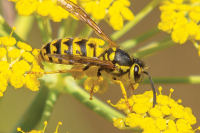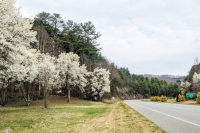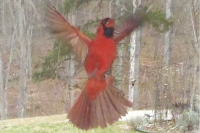Parkway rangers work to save hemlocks
With a massive die-off of hemlock trees all but imminent in the mountains, Ranger Chris Ulrey is putting faith in a handful of high-elevation hemlocks along the Blue Ridge Parkway to be the species’ saving grace.
A magnificent grove of old-growth hemlocks — some checking in at 400 years old — crowns Soco Gap above Maggie Valley. If Ulrey can save those trees, one day when the hemlock-killing insects have finally passed, the seeds of these survivors can blow down the mountain and settle in the coves, hopefully spawning a new generation of hemlock forests.
“Even if we can save a couple of trees, they will be important ecologically in the future because they will be our seed source trees,” said Ulrey, a botanist on the Parkway. “Maybe in 100 or 200 years we will have hemlocks again — but it will take a long time because they are a slow growing tree.”
Ulrey has also targeted an old stand of hemlocks on the Parkway above Shining Rock. The soil around the trees is injected with a pesticide, which the tree sucks up in its roots, warding off the life-threatening hemlock wooly adelgids when they try to attack.
Treating individual trees is labor intensive, so the Parkway has also tried releasing the predator beetles — an insect that eats the hemlock wooly adelgid and ideally will slow its destructive march. The Parkway gets batches of the predator beetles from the U.S. Forest Service, but there simply aren’t enough to go around, Ulrey said. The forest service can’t breed them fast enough.
The dearth of predator beetles means they haven’t reached the critical mass necessary for the plan to actually work.
Related Items
“They are still not able to really save trees because for every predator beetle out there, there are a gazillion adelgids because they reproduce so rapidly,” Ulrey said.
It seems there is only one thing that will slow the wooly adelgids — the death of the hemlocks. Hemlocks are the only tree the adelgids eat.
“When we see a major hemlock die-off, the adelgid population will crash,” Ulrey said. “It is inevitable the hemlocks are going to die.”
When the hemlocks die and the adelgid population crashes, the ratio of predator beetles to adelgids will be more aligned, and the predator beetles might be able keep the remaining adelgid population in check.
In the meantime, there is one thing that could help the hemlock rescue: more money from the federal government for beetles or the soil injection.
“If we get additional resources we can really expand our program,” Ulrey said.
The Parkway has saved about 2,000 hemlocks so far using the soil injection.
Other places on the Parkway, hemlocks have been saved for their aesthetic value. The grey skeletons of dead trees abutting the road, or at overlooks, picnic areas and campgrounds, will not only look bad, but would have to be cut down so they don’t fall on people, which would be more costly than treating them, Ulrey said.













